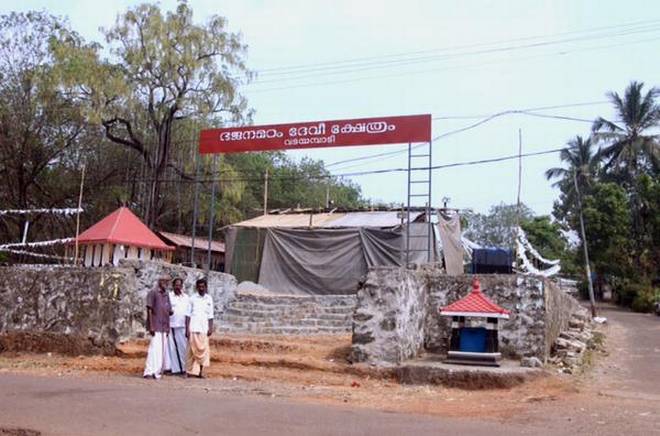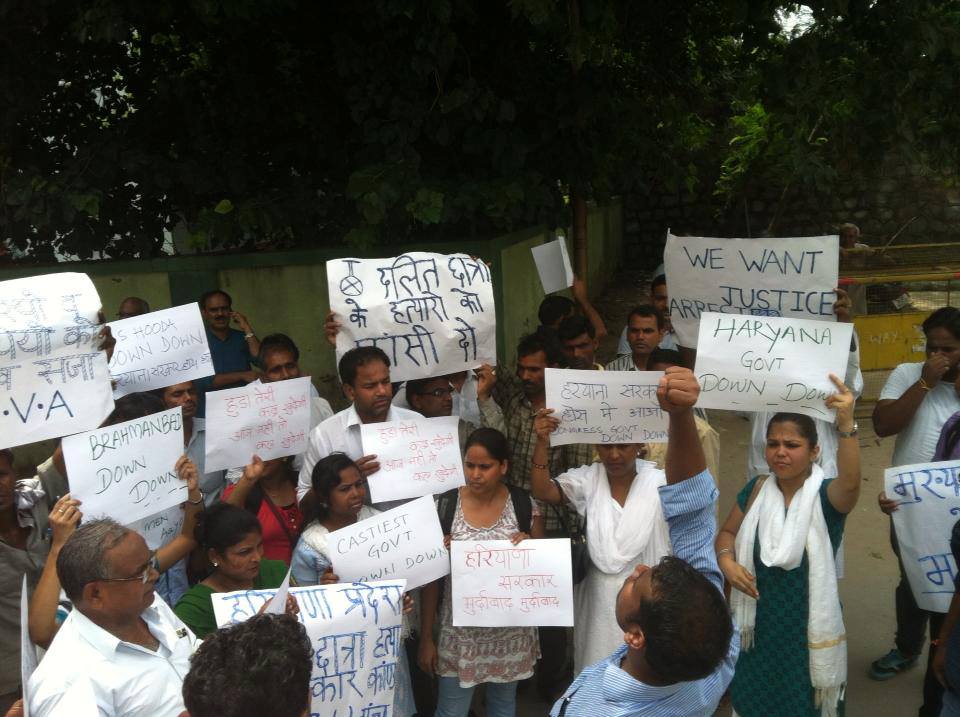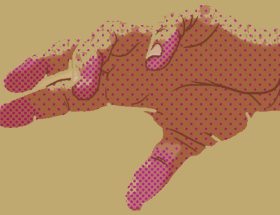T T Sreekumar
The Dalit land rights movement in Vadayambady, Kerala, against a ‘Caste Wall’ built by a Hindu temple run by the upper caste Nair Shudras and their organization called Nair Service Society (NSS) is one movement that need to be reckoned for its close relationship with the trajectories of the socio-political and economic history of anti-caste struggles in the region. The wall has been built around a playground that has been customarily used as common property by the Dalit communities living in the scheduled caste colonies surrounding the temple. An upper caste temple in the vicinity of the colonies itself is a testimony to the history of opportunistic land grabbing in the name of religion.

The temple is of a very recent origin and is built on a piece of land owned by a Nair who used to hold evening prayers there until his death. The NSS first acquired this private land, built the temple there and later clandestinely obtained the title deed for the revenue land lying adjacent to it, customarily used as common property by Dalits living in the colonies surrounding the land. Last year the temple began to deny entry to Dalits into the playground claiming ownership rights. When this move was challenged by the local Dalit community, the NSS, in complicity with the revenue authorities built a stone wall preventing the entry of Dalits into the filed. The local Dalit community which has been traditionally the users of the land symbolically pulled down part of the wall and started an agitation to reclaim their customary rights. The agitation resulted in unprecedented police brutality, the framing of false cases and arrests and torture of activists and also of reporters whom the police suspected of being sympathetic to the cause of the struggle. The ruling CPIM dispensation has unleashed a regime of terror and intimidation against the Dalit population who are determined to fight and expose the coercive tactics of the upper castes and terrorization by the state police.
Vadayambady land struggle brings to mind many crucial junctures in the history of Kerala from the Land Reform Acts that excluded the Dalits from the distribution of cultivable land to the various agitations to promulgate laws and amendments against the different forms of atrocities against Dalits and their social exclusion. It unleashes into the present moment, many important movements in history like the one in which Ezhavas and Dalits stopped the monetary offerings to the temples and also participation in external rituals, a temple-boycott movement that happened in the second decade of the 20th century. It is important to note that the temple boycott movement of the subaltern communities in Kerala preceded the much-celebrated Hindu reformist movements of the Shudra dissidents like K Kelappan, P Krishnapilla and A K Gopalan for equal ritual rights with that of the Brahmins. The latter movements, like the ‘temple-bell’ tolling protest and the like, were mostly to reclaim the Shudra pride, while the Dalit movements were essentially for the rights to reclaim the spaces that hurled them away and thus were powerful consolidations against the entrenched forms of untouchability. While the gap in the ritual status was a major concern for the upper caste Shudra agitators, Dalit communities mostly were concerned about their lack of access to common roads and exploitation in the name of religion.
For the Dalits, the temple was an economic institution and their relations to it were pre-determined by this understanding. On the other hand, the Shudra dissidents had their own community agendas to consider. The foundation of all Dalit protests against the institution of temples was the frustration against the denial of the most basic justice and rights to life that happened on a daily basis when the temples grabbed their legitimate rights to spaces by not even allowing them to use the lands in and around them. Though these protests later evolved and came to be understood as unified with the Shudra reformist movements, this interpretation largely negates the independent assertions and purposes that the Dalit movements against temples stood for. For the Shudra dissidents, the main incentive for consolidating this union was to gain support in their stand against the Nair matrilineal system which many of the young Shudras believed as degrading. As mentioned earlier, there was also the need for claiming more equal rights with the Brahmin castes.
Vadayambadi protest converges upon and brings to focus these historical moments. The protest was going on for over a year against the Nair Service Society’s illegal occupation of the commonly held village revenue land of which the customary rights belonged to the Dalits. That these lands were captured through title-deeds acquired discreetly accentuates the wrong. A legal battle also ensued with the Dalits challenging the unlawful privatization of collective property by the Nairs. Of late, the protest gained rigor and took new forms, when the Revenue Divisional Officer gave permission to Nairs to construct a wall around the illegally occupied common property to keep Dalits from entering the premises and exercising their customary rights over it. In response to an RTI filed, the village officer had conceded that even when the ‘Patta’ land had been gifted to the NSS, there are no official records about this possession and that according to the basic tax registers, the land is still marked as revenue land.
Following the Land reforms initiated by the Communist Parties, which obstinately denied cultivable land to Dalits and favored only upper caste tenants and a section of well to do Ezhavas, Christians, and Muslims, the Dalit community of Kerala was left largely banished and segregated into the scheduled caste and scheduled tribe colonies. For the ghettoized communities, the revenue lands around the colonies were the only cultural spaces that they could use for recreation and social bonding. The place adjacent to what is now known as ‘bhajanamadam’ is also a similar revenue land that was used by the local population in the colonies for years. NSS had furtively acquired the land probably through unofficial and illegitimate means and had kept this fact hidden for years. Recently, there was a row over the use of the land, following which the NSS had barred the Dalits from entering the premises. It is then that it came to light that NSS had acquired this land years ago in 1981, when a CPIM led ministry came to power in the State after a gap of 14 years.
Naturally, the handing over of a revenue land -a public property that belonged to the government and customarily used by Dalit communities- to the NSS looks fundamentally flawed and came to be questioned from all quarters. The civil society has a responsibility to support and protect the rights that marginalized communities have over public places, especially the rights that they possess over spaces that are part of their local histories. What the marginalized communities of Vadayambady now resist is the dominant bourgeoisie neo-liberal economic rationale that strives toward converting every public space into private property. Nowhere in the world can the civil society or the new left stand with this bourgeoisie intent against the marginalized people. They cannot stand with outdated concepts like “Hardin’s tragedy” that assume that public places will wear down due to overuse if they are not privatized. Public resources, including wetlands and forests, are certainly better off if they are collectively managed. Neoliberal governments, however, seldom pay heed to this caution either.
The land reform in Kerala has in effect, left astray a large section of Dalits who had legitimate rights over the cultivable land. With the phenomenal growth of the land market and emergence of the land mafias that throve to put their claim over every available nook and corner, the marginalized communities that were entirely dependent on these strips of land as their last means of sustenance and recreation became further and further sidelined. The problem in Vadayambady cannot be seen as an isolated issue. It is a continuation of this long history of land grabbing by caste Hindus in Kerala.
The immediate trigger that fired up this protest is the way the State’s police machinery acted as an instrument of Dalit oppression and violation of their human rights. Like how the Babri Masjid became the ‘disputed land’ for the soft Hindutva, the police and state machinery interpreted the land grab as a ‘land dispute’. Not only that, the state machinery had no hesitation regarding on whose side of the ‘dispute’ they stood. The police chose to attack and arrest the Dalit activists who had peacefully protested against the illegal occupation of their land. They removed the protest tent and allowed the temple authorities to construct an entrance to the temple at that place. Two young journalists who came to report the incident were arrested and labeled as Maoists. A false case was charged against the activist Joy who led the protest. He was even heartlessly dragged to the police van while he was having food. One of the leaders of the movement Sasidharan was brutally beaten up in an unprovoked attack and later arrested and tortured in custody.
When I visited Vadayambady the other day to express my solidarity with the cause of the agitation, what I witnessed there was an atmosphere of utmost fear and police terror. A big task force of police was stationed at the location. The team that included the special branch officers, had created a situation of terror at the peaceful site. Activists mentioned that a particular police officer continuously hurled abuses, including caste abuses, at the protesters that included Dalit women and children. When the protest began to draw national attention, the ruling dispensation of CPIM that had hitherto remained unconcerned has started to take up some damage control measures. However, when they finally arrived at the site of the agitation almost after a year since the agitation began, the CPIM leaders allegedly refused to address the caste question involved. Dalit activists, including women activists, surrounded them and raised several objections to this attitude pointing to their sheer hypocrisy and lack of integrity.
The demands raised by the Dalit organizations are loud and clear. Whether or not the Government or party has any sincerity or commitment toward the truth and facts of this issue, what they must immediately do is to officially nullify the title-deed that was illegitimately received by the NSS and also retrieve all the false cases leveled against those who were arrested at Vadayambady. They should also take stringent action against the police officers who committed atrocities and the officials who granted the permission to erect a ‘caste wall’ at the premise.
Strengthening the Vadayambady anti caste-wall struggle will give a new impetus to all land struggles of Dalits and Adivasis in the state and elsewhere. Kerala is increasingly becoming a Hindutva state under the CPIM regime. Temples and Hindutva organizations are emerging as civil arbitrators of everyday life with the complicity and connivance of the State police force. Most recently, when VK Mahesh, a well-known painter known as Artist Asanthan passed away at Kochi, his mortal remains were brought to the Art Gallery to pay public homage. A temple close by the gallery disallowed it arguing that it will cause pollution to the temple since the artist belonged to a Dalit caste. These incidents cannot anymore be seen as isolated. However, Pinarayi Vijayan, the Chief Minister, who is also holding the Home portfolio, is either unable to change or even control this situation or it can be presumed that he is open-handed in his active consent for the perpetuation of these injustices. No action has been taken against anyone in the above incidents although they fall under several reassuring articles and clauses against caste-based atrocities in the IPC as well as in the Indian constitution. The attempts to divide the Dalit agitators along party and religious lines have also so far not been quite successful. The movement’s immediate victory has been to effectively expose the nexus between the State police and Hindutva forces which thrives with the backing of the State government.
The Vadayambady movement invariably invokes many a moment in Kerala’s social history where struggles against exclusion from social spaces leading to cultural marginalization along with economic subjugation of Dalits and minorities had become the focus of major human rights mobilizations in the past. The movement can be legitimately seen as carrying forward those radical legacies. A persistent history of opportunistic inclusion, discriminatory exclusion and outright denial of public spaces mark the harrowing trajectories of increasing peripheralization of Dalit and Adivasi communities in Kerala. The agitation follows the arduous paths of heroic Dalit assertions and agitations that helped shape the democratic Kerala’s radical social history which were also relentless battles against caste based social segregation and economic and cultural isolation.
~~~
TT Sreekumar is a political observer and Professor in EFLU.
Picture courtesy: the internet.










